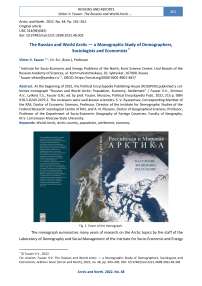The Russian and World Arctic — a Monographic Study of Demographers, Sociologists and Economists
Автор: Fauzer V.V.
Журнал: Arctic and North @arctic-and-north
Рубрика: Reviews and reports
Статья в выпуске: 48, 2022 года.
Бесплатный доступ
At the beginning of 2022, the Political Encyclopedia Publishing House (ROSSPEN) published a collective monograph “Russian and World Arctic: Population, Economy, Settlement” / Fauzer V.V., Smirnov A.V., Lytkina T.S., Fauzer G.N.; ed. by prof. Fauzer, Moscow, Political Encyclopedia Publ., 2022, 215 p. ISBN 978-5-8243-2479-2. The reviewers were well-known scientists: S. V. Ryazantsev, Corresponding Member of the RAS, Doctor of Economic Sciences, Professor, Director of the Institute for Demographic Studies of the Federal Research Sociological Centre of RAS, and A. N. Pilyasov, Doctor of Geographical Sciences, Professor, Professor of the Department of Socio-Economic Geography of Foreign Countries, Faculty of Geography, M.V. Lomonosov Moscow State University.
World Arctic, Arctic country, population, settlement, economy
Короткий адрес: https://sciup.org/148329258
IDR: 148329258 | УДК: 314(98)(045) | DOI: 10.37482/issn2221-2698.2022.48.303
Текст научной статьи The Russian and World Arctic — a Monographic Study of Demographers, Sociologists and Economists
Fig. 1. Cover of the monograph.
The monograph summarizes many years of research on the Arctic topics by the staff of the Laboratory of Demography and Social Management of the Institute for Socio-Economic and Energy
∗ © Fauzer V.V., 2022
Problems of the North of the Federal Research Center of the Komi Science Center of the Ural Branch of the Russian Academy of Sciences. The focus is on eight Arctic states: Russia, Canada, USA, Norway, Denmark, Finland, Sweden and Iceland. The study of the World Arctic is based on official publications and databases of the statistical agencies of these Arctic countries. International databases on settlement and regional population (citypopulation.de), spatial distribution of settlements (geonames.org), and climatic conditions (climate-data.org) were also used. The sources of data on the Russian Arctic are the results of population censuses from 1897 to 2010; statistical bulletins and collections of the Federal State Statistics Service (Rosstat); statistical information on the socio-economic development of the Russian Arctic, collected in accordance with the Federal Plan of Statistical Works; publications of ministries and departments; data from the Unified Interdepartmental Statistical Information System (EMISS).
The paper considers the history of the development and settlement of the Russian and World Arctic; approaches to the study of demographic problems and the settlement of the Arctic territories; considers the features of population formation and the specifics of its distribution; explains the differentiation of the Arctic territories in terms of population density and economic development. The author’s methodology of determining the basic settlements is offered; the classification of urban settlements according to their correspondence to the basic ones is given on its basis. Local labor markets are discussed in detail, their classification by types of economic activity is given. The migration of the population of the Russian Arctic has received considerable attention, the main models and preferred routes of migration are highlighted. The municipal human development index is used to describe human development and the prospects for a knowledge-based economy in the Russian Arctic.
Another reason for the Arctic’s interest is that it is the place of residence of indigenous peoples, who are referred to as the “fourth world” in international political discourse. In Russia, they are called a special community of the “fourth dimension”, which forms an ecological system of values, as well as “saviors of civilization”.
The publication was financially supported by the Russian Foundation for Basic Research under the project No. 21-110-00049 (2021, supervised by V.V. Fauzer). According to the terms of the competition, the main circulation (300 copies) was sent to the largest libraries and scientific and educational organizations in Russia. These are Arkhangelsk and Murmansk regional scientific libraries; national libraries of Komi Republic, Republic of Karelia and Sakha Republic (Yakutia); Komi and Karelian scientific centres; Northern (Arctic) and North-Eastern federal universities; Murmansk, Petrozavodsk and Syktyvkar state universities. The electronic version of the monograph will be available for reading on the website of the Russian Foundation for Basic Research in the second half of 2022. The book from the additional edition (500 copies) can be purchased on the website of the Political Encyclopedia publishing house and in online bookstores.
Arctic and North. 2022. No. 48


